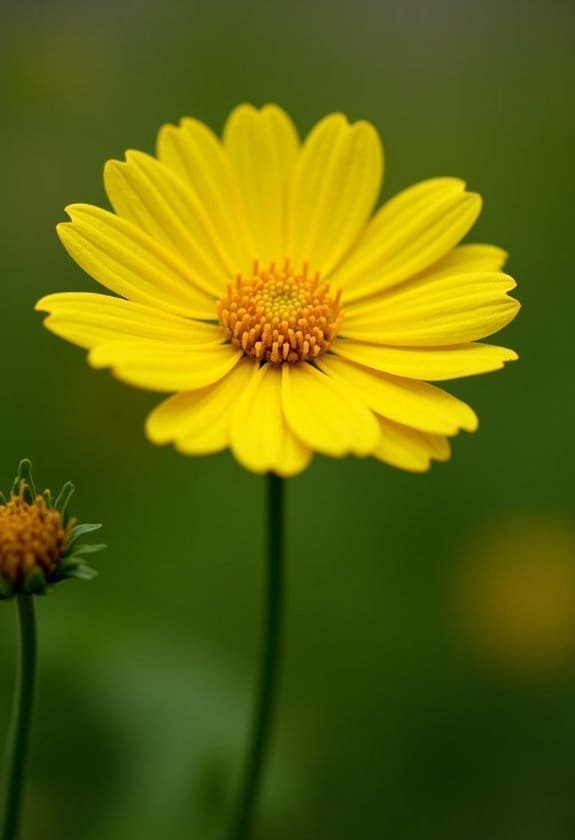Glebionis segetum, commonly known as Corn Marigold, is a striking Mediterranean native featuring bright yellow daisy-like blooms measuring 3.5 to 5.5 cm in diameter. This versatile plant reaches heights of 80 cm and displays deeply lobed, feathery foliage arranged in spiral patterns along its stems. It's proven invaluable as a nectar source for pollinators, particularly bees and hoverflies, while its young shoots offer culinary potential. Though historically considered an agricultural weed, it thrives in full sunlight and well-draining soils, blooming from June through October. Modern gardeners and ecologists are discovering there's more to this golden-flowered beauty than meets the eye.
Main Points
- Glebionis segetum, commonly known as Corn Marigold, is a flowering plant with bright yellow, daisy-like blooms measuring 3.5-5.5 cm in diameter.
- Native to the eastern Mediterranean, this plant grows up to 80 cm tall and features deeply lobed, feathery leaves arranged spirally.
- The plant blooms from June through October, thriving in full sunlight and well-draining soils while providing essential nectar for pollinators.
- Previously classified as Chrysanthemum segetum until 1999, its name "segetum" means "of the cornfields," reflecting its traditional habitat.
- While considered an agricultural weed, Corn Marigold offers ecological benefits through pollinator support and has edible young shoots.
Introduction

Corn marigold (Glebionis segetum) stands as a vibrant member of the daisy family, recognized for its brilliant yellow blooms that light up agricultural landscapes across Europe and the Mediterranean region.
The plant's distinctive flowers, measuring 3.5-5.5 centimeters in diameter, feature a striking combination of ray and disc florets that create its characteristic sun-like appearance.
Though historically viewed as an agricultural nuisance, this annual herbaceous species has earned recognition for its ecological value, serving as an essential nectar source for diverse pollinators throughout its extended flowering period.
Common Name
Known widely as the Corn Marigold, Glebionis segetum carries several common names that reflect its natural habitat and appearance. This striking plant's primary designation emerged from its historical presence in European cornfields, where it once flourished abundantly among cereal crops. The name effectively captures both its preferred growing environment and its agricultural heritage.
The species has acquired multiple alternative names throughout different regions and time periods, each highlighting distinct aspects of its character. "Field Marigold" and "Golden Marigold" emphasize the plant's brilliant yellow blooms, which illuminate agricultural landscapes with their vibrant presence.
The designation "Corn Daisy" acknowledges its structural similarity to common daisies, particularly in its flower formation and petal arrangement.
While these various names celebrate the plant's aesthetic qualities, they also hint at its complex relationship with agriculture. Despite its ornamental appeal and historical significance in traditional English gardens, farmers often regard Glebionis segetum as an agricultural weed due to its competitive nature and tendency to spread rapidly through cultivated fields.
Scientific Name
The scientific classification Glebionis segetum represents the current taxonomic designation for the Corn Marigold, though botanists previously recognized it as Chrysanthemum segetum until 1999. This significant nomenclatural change emerged from decisions made at the International Botanical Congress, reflecting evolving understanding of plant relationships within the Asteraceae family.
The scientific name carries meaningful botanical heritage, particularly in its specific epithet "segetum," which derives from Latin and translates to "of the cornfields." This etymology perfectly captures the plant's historical ecological niche, as it frequently appears in agricultural landscapes alongside cereal crops.
Importantly, the epithet maintains its original form regardless of the genus name's gender, adhering to botanical naming conventions.
The plant's current placement in the genus Glebionis reflects its distinct characteristics, including its bright yellow flowers and deeply lobed foliage, which distinguish it from true chrysanthemums.
This reclassification demonstrates how scientific names evolve to better represent our understanding of plant relationships and evolutionary history within the broader context of botanical taxonomy.
Overview
Standing prominently among agricultural landscapes, Glebionis segetum represents a striking annual herb characterized by its bright yellow, daisy-like blooms and distinctive foliage. This resilient plant, commonly known as Corn Marigold, reaches impressive heights of up to 80 centimeters and produces vibrant yellow flowers measuring 3.5 to 5.5 centimeters in diameter.
Originally native to the eastern Mediterranean region, this species has demonstrated remarkable adaptability, establishing itself across Europe, China, and North America. While it's often regarded as an invasive weed in agricultural settings, the plant's ecological contributions can't be overlooked. Its abundant nectar and pollen production creates an essential resource for pollinators, particularly bees and hoverflies, contributing considerably to local biodiversity.
The plant's complex relationship with human activities reflects nature's intricate balance, as it simultaneously poses challenges as an agricultural competitor while offering sustenance through its edible young shoots.
Following its taxonomic reclassification in 1999, this former member of the Chrysanthemum genus continues to captivate botanists and ecological researchers with its adaptive capabilities and environmental impact.
Key Features
The Corn Marigold stands as a striking annual plant, reaching impressive heights of up to 80 centimeters with its distinct feathery leaves arranged in a spiral pattern along the stem.
Its most notable feature is the brilliant yellow, daisy-like flowers that measure 3.5 to 5.5 centimeters across, creating eye-catching displays in agricultural landscapes and disturbed soils.
The plant maintains a remarkable blooming period from June through October, making it a crucial nectar source for pollinators throughout the growing season.
Growth Size
During its growing season, corn marigold develops into a striking herbaceous annual plant, reaching impressive heights of up to 80 cm (31 inches). This remarkable growth pattern is complemented by its expansive foliage system, featuring deeply lobed leaves that spiral elegantly around the stem in a distinctive arrangement.
The plant's structural dimensions are particularly significant, with individual leaves extending between 5 to 20 cm in length, creating a substantial visual presence in garden settings. These mid-green to blue-green leaves serve as a perfect backdrop for the plant's crowning feature: its vibrant yellow blooms measuring 3.5 to 5.5 cm in diameter.
The overall growth size of corn marigold creates an appealing vertical element in gardens, while its spreading habit helps establish a robust presence within planted areas. Throughout its extended blooming period from June to October, the plant maintains its impressive stature, making it an excellent choice for both ornamental and naturalized settings.
This sustained growth pattern, combined with its substantial height and spread, allows corn marigold to serve as an effective mid-layer planting option in mixed borders.
Appearance
Visually striking and immediately recognizable, corn marigold commands attention with its bright yellow, daisy-like blooms that measure 3.5-5.5 cm across. These distinctive flowers feature a ring of ray florets encircling a center composed of densely packed disc florets, creating a radiant display that stands out in any meadow setting.
The plant's foliage presents an equally compelling visual element, with spirally arranged leaves exhibiting a sophisticated architectural design. These deeply lobed leaves, ranging from 5 to 20 cm in length, create a feathery texture that complements the bold flowers above.
The foliage displays a subtle variation in color, shifting between mid-green and blue-green hues, while its size and complexity diminish gradually toward the upper portions of the stem.
During its extended flowering period from June through October, the corn marigold maintains its striking appearance, with multiple blooms often appearing simultaneously on a single plant.
The overall structure reaches heights of up to 80 cm, creating an impressive silhouette that combines the architectural grace of its divided leaves with the luminous appeal of its bright yellow flowers.
Flowering Season
Brightening fields and meadows from June through October, corn marigold produces an impressive display of vibrant yellow blooms that persist throughout the warm summer months. These striking daisy-like flowers, measuring between 3.5 to 5.5 centimeters in diameter, create golden carpets across disturbed landscapes and agricultural areas during their extended flowering period.
The prolonged blooming season of Glebionis segetum plays a vital ecological role in supporting local biodiversity. As these yellow flowers maintain their presence through summer and early autumn, they serve as reliable nectar and pollen sources for numerous insect species.
The plant's preference for sunny, disturbed habitats, such as arable fields and road verges, makes it particularly visible during its flowering phase.
The flowering pattern of corn marigold aligns perfectly with peak growing seasons, allowing it to establish robust populations in various environments. Its ability to thrive in disturbed areas, combined with its extended flowering period, guarantees that these golden blooms remain a distinctive feature of the landscape for nearly half the year.
Growing Requirements

Corn Marigold's growing requirements align perfectly with its native habitat preferences, thriving in full sunlight and well-draining soils that mimic its natural environment in arable fields.
The plant adapts remarkably well to various soil conditions but performs best in moderately moist, fertile ground at a planting depth of 1-2 cm, where its extensive root system can establish effectively.
Its temperature tolerance and extended blooming period from June through October make it a versatile choice for gardens across diverse climate zones, though it requires careful management to prevent excessive self-seeding in cultivated spaces.
Light
Like many sun-loving plants, the corn marigold demands full sunlight for optimal growth and flower production. To thrive, these vibrant yellow blooms require a minimum of six hours of direct sunlight daily, which fuels their photosynthetic processes and supports robust development.
The relationship between sunlight exposure and the corn marigold's flowering cycle is particularly remarkable, as adequate light directly influences its extended blooming period from June through October. When positioned in ideal light conditions, these plants transform into powerful pollinator magnets, producing abundant nectar that attracts diverse insects, including bees and butterflies.
The intense sunlight not only stimulates flower production but also strengthens the plant's overall structure and health.
While corn marigolds can survive in partially shaded conditions, their performance considerably diminishes without proper light exposure. The plants demonstrate their solar dependence through more vigorous growth and more prolific flowering when basking in full sun, making them excellent choices for open gardens, meadows, and agricultural settings where sunlight reaches them unobstructed throughout the day.
Soil
Typically found thriving in agricultural settings, corn marigold exhibits specific preferences for soil conditions that support its vigorous growth. The plant demonstrates remarkable adaptability to various soil compositions but shows particular affinity for well-aerated, free-draining substrates that prevent waterlogging and promote robust root development.
In its natural habitat, corn marigold flourishes in disturbed ground, where soil disruption creates the ideal growing environment for this resilient species. These areas often provide the perfect balance of nutrients and drainage that the plant requires for peak performance.
While not particularly demanding regarding soil pH, the species tends to perform best in slightly acidic to neutral conditions, typically ranging between 6.0 and 7.0 on the pH scale. The key to successful cultivation lies in maintaining proper soil moisture levels, as excessive water retention can compromise plant health.
Agricultural environments, with their regularly worked soil structure, create an ideal foundation for corn marigold's establishment, allowing it to capitalize on the enhanced soil aeration and nutrient availability that comes with cultivation practices.
Water
Water management plays an essential role in cultivating healthy corn marigold plants, requiring a balanced approach that prevents both drought stress and oversaturation. These resilient annuals demonstrate remarkable adaptability to varying moisture conditions, though they perform best with moderate watering practices that mirror their natural habitat preferences.
During the establishment phase, corn marigolds benefit from consistent moisture levels that keep the soil evenly damp but never waterlogged. Once the plants have developed strong root systems, they exhibit impressive drought tolerance, making them particularly well-suited for gardens in regions with unpredictable rainfall patterns.
Regular monitoring of soil moisture becomes vital during extended dry spells, as supplemental watering may be necessary to maintain ideal growth and flowering.
The key to successful water management lies in understanding the plant's natural resistance to oversaturation. Allowing the soil to dry slightly between watering sessions helps prevent root rot, a common problem that occurs when excess moisture remains trapped around the root zone.
This practice aligns perfectly with the corn marigold's preference for well-drained growing conditions.
Temperature
Temperature requirements complement the watering needs of corn marigolds, with these vibrant annuals flourishing in warm environments between 15°C to 25°C (59°F to 77°F).
These ideal temperatures create perfect conditions for robust growth and abundant flowering, particularly during the peak summer months from June through October.
While corn marigolds demonstrate some resilience to temperature fluctuations, they're significantly sensitive to frost conditions, which can severely impact young seedlings and developing plants.
The species thrives when positioned in full sun locations, where consistent warmth enhances both vegetative growth and flower production throughout the growing season.
Maintaining appropriate temperature conditions becomes especially essential when considering soil moisture levels, as cooler temperatures combined with excess water can promote detrimental root rot conditions.
Experienced gardeners often monitor temperature patterns closely during the early growing stages, providing protection if unexpected temperature drops threaten young plants.
For ideal results, growers should select planting sites that offer consistent warmth and protection from cold drafts, while ensuring adequate drainage to prevent moisture-related issues during cooler periods.
Pollinator Criteria
The Corn Marigold's bright yellow blooms serve as powerful pollinator magnets, attracting an array of beneficial insects from June through October.
The flowers produce abundant nectar comparable to cornflowers, making them particularly appealing to small butterflies and hoverflies that play essential roles in local ecosystem stability.
These prolific plants contribute greatly to urban and agricultural biodiversity by providing consistent nectar resources throughout the growing season, supporting diverse pollinator populations in both cultivated and naturalized settings.
Attracted Pollinators
Numerous pollinators are drawn to Corn Marigold's abundant nectar production and vibrant yellow blooms, establishing it as an essential resource in UK meadows. The plant's distinctive flower structure, featuring a ring of ray florets surrounding central disc florets, creates an ideal landing platform for visiting insects.
Among the most frequent visitors are bees and hoverflies, which are particularly attracted to the flower's high nectar content and easily accessible pollen resources. Small butterflies navigate the flower's architecture with remarkable precision, utilizing the ray florets as convenient perches while feeding.
The extended flowering period, spanning from June through October, guarantees a reliable food source for these beneficial insects throughout the growing season.
In urban settings and agricultural landscapes, Corn Marigold's adaptability to disturbed soils makes it an invaluable supporter of pollinator diversity. Its presence in flower meadows creates essential feeding stations for declining insect populations, while its competitive nature allows it to establish strong populations that can sustain multiple pollinator species simultaneously, contributing to the overall health of local ecosystems.
Pollination Method
Cross-pollination drives Corn Marigold's reproductive success through specialized floral adaptations that attract diverse insect visitors. The plant's distinctive combination of ray and disc florets creates an efficient landing platform for pollinators, while simultaneously offering accessible nectar rewards that encourage extended foraging visits.
The pollination mechanism relies heavily on the synchronized activity of small butterflies and hoverflies, which transfer pollen between individual plants during their nectar-gathering flights. From June through October, the bright yellow blooms maintain consistent nectar production, establishing a reliable food source that supports sustained pollinator activity throughout the growing season.
The plant's extended flowering period guarantees successful cross-pollination by maintaining a steady stream of insect visitors.
In urban environments, where pollinator populations face increasing pressure, Corn Marigold's abundant floral resources play an essential role in facilitating effective pollination networks. The plant's nectar-rich flowers serve as critical connecting points in the larger ecosystem, supporting pollinator diversity while simultaneously securing their own reproductive success through consistent cross-pollination events.
Care & Maintenance

Corn marigold's care requirements center around providing well-draining soil and ample sunlight, making it an exceptionally low-maintenance addition to gardens and wildflower meadows.
Regular deadheading of spent blooms throughout the growing season encourages continuous flowering while preventing aggressive self-seeding, which can help maintain the plant's desired distribution within the landscape.
The plant thrives when paired with compatible meadow species like cornflowers and poppies, creating a naturalistic display that supports local pollinators while requiring minimal intervention beyond occasional monitoring and selective removal.
Planting Tips
Growing success with Corn Marigold starts with proper planting and ongoing care. These resilient annuals flourish when introduced to well-draining soil in locations that receive abundant sunlight throughout the growing season.
For best results, gardeners should prepare their planting sites by loosening the soil and incorporating organic matter, though Glebionis segetum demonstrates remarkable adaptability to poor soil conditions.
When implementing planting tips for marigold cultivation, timing plays a significant role in establishing healthy specimens. Early spring sowing yields the most vigorous growth, as the plants can develop robust root systems before the summer heat arrives.
While direct seeding proves most effective, maintaining proper spacing of 12-15 inches between plants guarantees adequate air circulation and prevents overcrowding. The seeds should be lightly covered with soil, as they require some light for germination.
To maintain control over the plant's natural spreading tendency, it's important to monitor self-seeding patterns and remove unwanted seedlings before they become established.
Regular deadheading not only promotes continuous blooming but also helps manage the plant's distribution throughout the garden space.
Ongoing Care
Maintaining healthy Corn Marigolds requires attention to a few key care practices throughout their growing season. Regular monitoring of self-seeding patterns helps gardeners manage the plant's natural tendency to spread, ensuring it remains within desired boundaries while still contributing to the garden's biodiversity.
A critical aspect of ongoing care involves the selective removal of competing weeds, which enables Corn Marigolds to access essential nutrients and maintain ideal growth in their preferred disturbed soil conditions.
Through consistent deadheading of spent blooms, gardeners can extend the flowering period from early summer through autumn, maximizing the plant's ornamental value and supporting local pollinator populations.
While some might view its vigorous growth as potentially problematic, implementing strategic management practices allows gardeners to harness the Corn Marigold's beneficial qualities while preventing unwanted spread.
This balanced approach to cultivation includes maintaining well-draining soil conditions and ensuring adequate sunlight exposure, which ultimately contributes to the plant's robust performance and its role in enhancing garden ecosystems.
Suggested Companions
When planning a garden design with Corn Marigolds, selecting the right companion plants enhances both aesthetic appeal and ecological benefits. The striking yellow blooms of Glebionis segetum create a particularly harmonious display when paired with cornflowers (Centaurea cyanus) and poppies in a naturalistic meadow setting.
Successful companion planting requires careful consideration of growing conditions, as all selected species should thrive in similar environments. These annual wildflowers perform best in sunny locations with well-draining soil, creating a synchronized display that evolves throughout the growing season.
While corn marigolds maintain their vibrant presence, complementary plants contribute to a dynamic tapestry of colors and forms.
Gardeners should monitor the interaction between corn marigolds and their companion plants, as these enthusiastic self-seeders can spread rapidly within the garden space. The strategic placement of beneficial companion plants, such as those that attract pollinators and other helpful insects, creates an ecosystem that supports garden health while maximizing biodiversity.
This thoughtful approach to companion planting transforms a simple flower bed into a thriving botanical community.
What Are the Differences Between Chicory and Corn Marigold in Their Uses and Habitat?
Chicory and corn marigold differ greatly in their uses and habitat. While chicory thrives in well-drained soils and is valued for the health benefits of chicory plant, including improved digestion, corn marigold prefers acidic soils and serves mainly as a decorative wildflower, lacking the medicinal and culinary advantages associated with chicory.
Common Issues
While Corn Marigold itself is often considered a pest in agricultural settings, the plant faces its own set of challenges from various insects and fungal pathogens that can affect its growth and development.
Common pests include aphids and leaf-mining insects, which can cause significant damage to the foliage by feeding on plant tissues and creating distinctive tunneling patterns.
Effective management typically involves a combination of cultural controls, such as maintaining proper plant spacing and air circulation, along with targeted applications of insecticidal soaps or appropriate fungicides when necessary.
Pests/Diseases
Despite its hardy nature, corn marigold faces several potential threats from pests and diseases. The most common pest challenge comes from aphids, which not only weaken the plant's structural integrity but can also serve as vectors for various viral infections that compromise the plant's health. These tiny insects often establish colonies on tender growth, leading to stunted development and reduced flowering capacity.
In environments with high humidity, powdery mildew emerges as a significant concern, manifesting as a distinctive white, powder-like coating on the plant's foliage and stems. This fungal invasion can severely impair the plant's photosynthetic capabilities, ultimately affecting its overall importance and bloom production.
When grown in poorly draining soils, root rot becomes a particular threat, causing the plant's foliage to yellow and wilt progressively. Additionally, competitive weeds can strain the plant's access to crucial nutrients and water resources.
To maintain ideal plant health, gardeners should implement regular monitoring practices and guarantee proper spacing between plants, which promotes adequate air circulation and reduces disease susceptibility.
Solutions
Effective management of corn marigold requires a multi-faceted approach to address its persistent nature. As a problematic weed in agricultural settings, it demands careful monitoring and implementation of thorough control strategies to prevent its spread and minimize crop yield losses.
Chemical control through targeted herbicide applications, particularly with products like Paramount Max and Compitox Plus, has proven effective when used as part of an integrated management plan. These treatments should be timed strategically during the growing season to maximize their impact on the weed population while protecting the primary crop.
Cultural control methods complement chemical interventions by focusing on prevention and long-term management. Farmers should implement regular field monitoring protocols, adjust cultivation practices, and maintain detailed records of infestation patterns to develop site-specific management strategies.
Given the plant's ability to produce numerous viable seeds that can remain dormant in the soil for years, sustained vigilance is essential for successful control. The integration of these approaches, combined with proper identification techniques to distinguish corn marigold from similar species, provides the most promising pathway for managing this persistent agricultural challenge.
Summary

The resilience of Corn Marigold (Glebionis segetum) has shaped its remarkable journey from agricultural menace to vulnerable species. Once considered a serious weed in Scottish fields, this Mediterranean native faced legal restrictions during the 13th century due to its persistent spread through croplands.
Today, this herbaceous annual presents a fascinating ecological paradox, as its historical abundance has given way to vulnerability in modern landscapes. Rising to heights of 80 centimeters, the plant's distinctive yellow blooms grace disturbed soils from June through October, with impressive flower heads spanning 3.5 to 5.5 centimeters in diameter.
While agricultural intensification and habitat loss have greatly reduced its populations, the species maintains its cultural significance through its culinary applications, as its young shoots and leaves continue to be valued in traditional cooking.
The Corn Marigold's story exemplifies nature's delicate balance between agricultural management and biodiversity conservation, highlighting how human practices can transform a once-abundant species into one requiring protection.
This transformation underscores the importance of sustainable farming practices that can accommodate both crop production and wildlife preservation.


